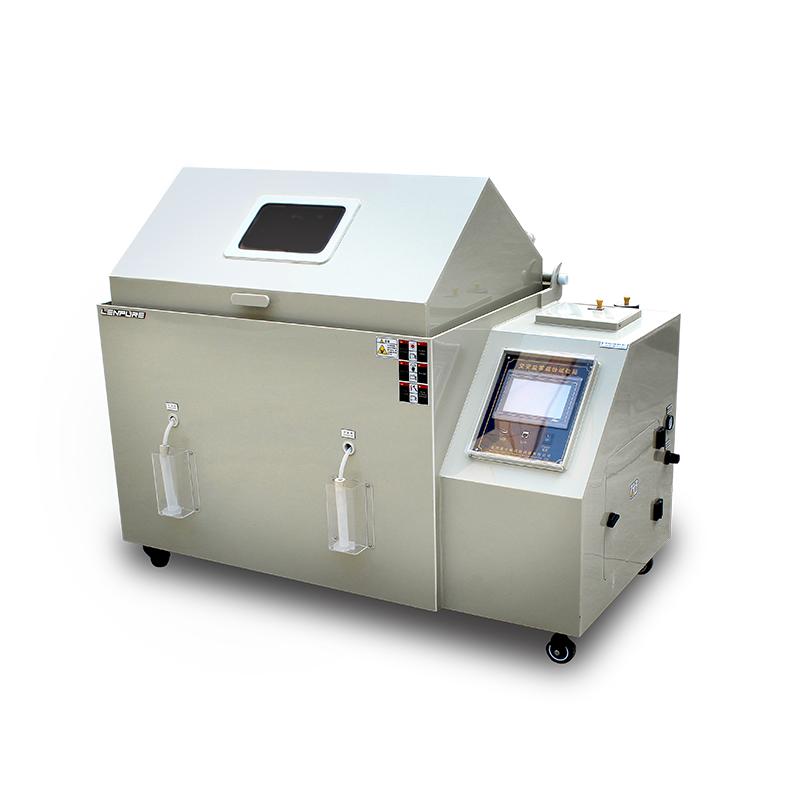

Salt spray testing is an essential method for evaluating the corrosion resistance of metal products, electronic components, and other items. By simulating a highly corrosive environment with a salt spray test chamber, companies can identify potential issues that may arise under harsh conditions. In this article, we will delve into the principles, standards, equipment, and procedures of salt spray testing.

I. Testing Principle
The core principle of salt spray testing is to simulate a highly corrosive environment with high salt concentration, similar to that found in nature, to accelerate the corrosion process on the surface of the products. This allows for the assessment of their corrosion resistance. Inside the test chamber, a specific device converts the prepared salt solution into salt spray particles, which are then evenly dispersed throughout the chamber.
II. Testing Standards
Different industries have established various salt spray testing standards based on the usage scenarios and performance requirements of the products.
In the automotive industry, GB/T 10125 “Artificial Atmosphere Corrosion Testing – Salt Spray Testing” is an important reference. This standard specifies several testing methods, including Neutral Salt Spray Test (NSS), Acetic Acid Salt Spray Test (AASS), and Copper Accelerated Acetic Acid Salt Spray Test (CASS). Generally, automotive parts are subjected to the neutral salt spray test, which requires continuous spraying in an environment with a temperature of 35°C and a salt solution concentration of 5% for tens or even hundreds of hours. The surfaces of the parts are then observed for corrosion, discoloration, or other phenomena to ensure that vehicles can operate normally in coastal areas or regions where de-icing salts are used in winter.
III. Testing Equipment: Characteristics of the Salt Spray Test Chamber
The salt spray test chamber is the key equipment for conducting salt spray tests, and its structure and performance directly affect the accuracy of the test results.
In terms of structure, a salt spray test chamber typically consists of a chamber body, a spray system, a saltwater tank, a heating system, and a control system. The chamber body is usually made of high-quality corrosion-resistant materials, such as PP (polypropylene) panels, which have excellent acid and alkali resistance. The chamber lid is designed in a conical shape to prevent condensed salt spray droplets from dripping directly onto the sample surface, which could affect the test results. The spray system is the core component of the salt spray test chamber, comprising a spray tower and nozzles. The spray tower has internal air and saltwater channels, and by adjusting the air pressure and saltwater flow, the generation and particle size of the salt spray can be controlled. The nozzles are made of special materials to ensure they do not corrode in a high-salt environment and can spray evenly. The saltwater tank stores the prepared salt solution, while the heating system regulates the temperature inside the chamber to meet the test standard requirements. The control system can monitor parameters such as temperature, humidity, and salt spray deposition rate in real-time and automatically adjust according to the set program to ensure stable test conditions.
IV. Testing Procedure
Sample Preparation
Before testing, thoroughly inspect and clean the samples to remove surface contaminants such as oil and dust, ensuring that the sample surface meets the test requirements. For coated samples, check the integrity of the coating; for metal products, record their initial appearance. Also, prepare sufficient salt solution according to the test standard and the number of samples.
Sample Placement
Place the samples steadily on the sample rack inside the salt spray test chamber, ensuring that there is a certain gap between the samples to avoid shading each other and allowing each sample to be fully exposed to the salt spray. Depending on the characteristics of the samples, different placement methods can be chosen, such as laying flat or hanging. For small parts, special fixtures can be used to secure them.
Parameter Setting
Based on the test standard and product requirements, set the test temperature, salt solution concentration, spray time, and intermittent time in the chamber’s control system. For example, during a neutral salt spray test, the temperature is usually set at 35°C, with a salt solution concentration of 5%, continuous spraying, and no intermittent time.
Test Initiation
After setting the parameters, start the salt spray test chamber. First, inject the prepared salt solution into the saltwater tank, then turn on the heating system to raise the temperature inside the chamber to the set value. Once the temperature stabilizes, activate the spray system, and the salt spray will begin to disperse evenly inside the chamber. During the test, the operator needs to closely monitor the running status of the test chamber to ensure that all parameters remain stable within the set range.
Process Monitoring
During the test, regularly observe the condition of the samples and record the time and extent of corrosion on the sample surfaces. Check the salt spray deposition rate collected by the salt spray collector to ensure it meets the standard. If it does not, adjust the spray system parameters promptly. Additionally, monitor the temperature and humidity of the test chamber to ensure a stable testing environment.
Detection and Evaluation
When the test reaches the specified duration, stop the spraying and turn off the test chamber. After the temperature inside the chamber drops to room temperature, remove the samples, rinse off the residual salt spray with water, and then dry them. Assess the degree of corrosion on the samples through visual inspection, metallographic microscope examination, and other methods. Compare the results with the initial state before the test to determine whether the product passes the salt spray test. If the product shows severe corrosion, analyze the cause and improve and optimize the product’s protective process.